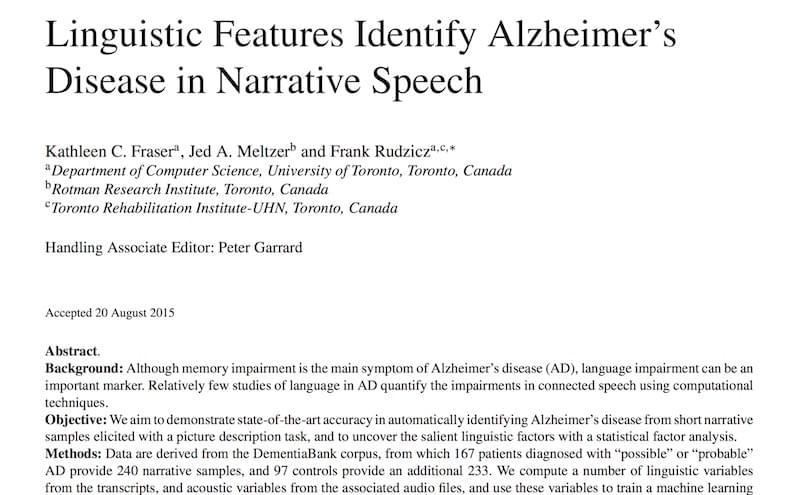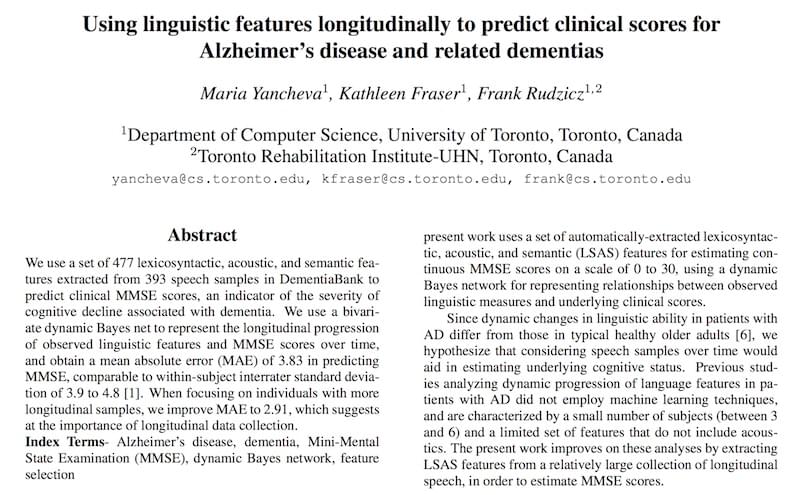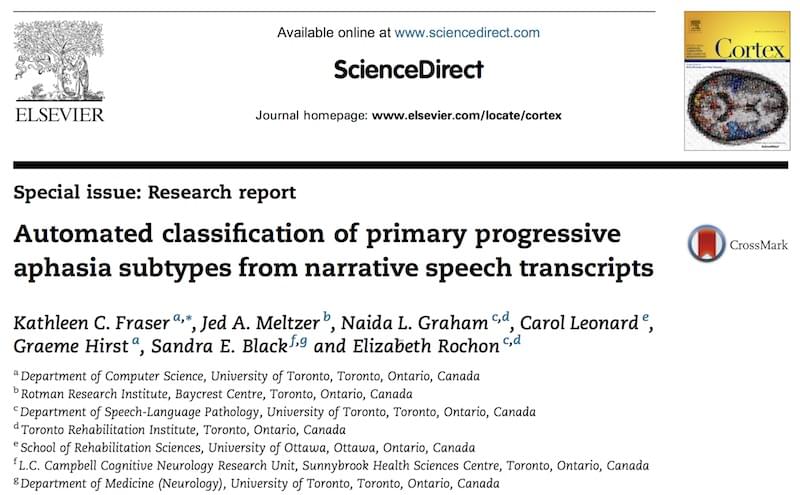Detect changes in neurological and psychiatric symptoms faster, more easily, and more objectively through speech with the help of natural language processing and artificial intelligence.
Work with us
Analysis of spontaneous speech data elicited through Cookie Theft picture description (1-5 minute samples) from 240 people probable AD category and 233 healthy controls. Linguistic and acoustic variables used to train a machine learning classifier to distinguish between the groups, with 82% accuracy.
Fraser, K. C., Meltzer, J. A., & Rudzicz, F. (2016). Linguistic features identify Alzheimer’s disease in narrative speech. Journal of Alzheimer's Disease, 49(2), 407-422.
A temporal Bayes network trained on 182 lexicosyntactic, 210 acoustic, and 85 semantic features extracted from 393 spontaneous speech samples elicited through Cookie Theft picture description can predict MMSE scores with a mean absolute error of 3.8, comparable to within-subject interrater (clinician) standard deviation of 3.9 to 4.8.
Yancheva, M., Fraser, K., & Rudzicz, F. (2015). Using Linguistic Features Longitudinally to Predict Clinical Scores for Alzheimer's Disease and Related Dementias.
Syntactic and semantic features were automatically extracted from transcriptions of narrative speech for three groups: semantic dementia (SD), progressive nonfluent aphasia (PNFA), and healthy controls. Machine learning classifiers trained on these features were able to distinguish between the three participant groups with up to 100% accuracy.
Fraser, K.C., Meltzer, J.A., Graham, N.L., Leonard, C., Hirst, G., Black, S.E., & Rochon, E. (2014). Automated classification of primary progressive aphasia subtypes from narrative speech transcripts. Cortex, 55, 43-60.Drug development in neuroscience is hampered by insensitive clinical scales which may not detect subtle changes in symptoms. By extracting over 550 features of speech and language, Winterlight Labs’ technology can measure fine-grained changes that traditional assessments cannot. Our algorithms then use these features to classify heterogeneous disease populations into subgroups, track change over time, and detect response to treatment. Winterlight’s speech assessment is deployed in a dozen clinical studies spanning Alzheimer’s disease, frontotemporal dementia, depression, bipolar disorder, and schizophrenia.

Traditional endpoints are complex, stressful for patients, require specialized training to administer consistently and are challenging to deliver remotely. Our technology is flexible and simple to use. It can be administered by research staff in traditional clinic settings, while also serving as a higher frequency, digital patient reported outcome (PRO) in decentralized trial designs.
The assessment can be completed objectively across patients and administrators. Standard cognitive assessments include components which are subjectively scored and often too coarse. We analyze hundreds of linguistic cues and vocal biomarkers to detect Alzheimer’s disease and other conditions with accuracies between 82% and 100%, as reported in our peer-reviewed academic studies.
Our approach goes beyond analyzing the acoustic properties of speech, and also includes the linguistic components of speech, such as word choice, sentence structure, and coherence of ideas to produce a set of over 550 variables. These variables can be grouped into composite metrics such as word-finding difficulty, syntactic complexity, lexical richness, discourse mapping and more.
We recognize that every clinical development program is unique and so we offer different ways to work with Winterlight as part of your clinical research program. We have developed our own Winterlight Assessment App with customizable tasks that can be used to collect speech data throughout the study, or we can integrate into existing data collection tools via API. We also have the capability to retrospectively analyze data that has been previously collected by other means.
Spilka, M. J., Xu, M., Toth, B., Hashemifar, S., Amora, R., Robin, J., Teng, E., Monteiro, C., Simpson, W. (2025)
2025 Alzheimer’s Association International Conference (AAIC).
Read
De Lillo, M., Xu, M., Spilka, M. J., Cormack, F. K., Robin, J., Fuchs, K., Wenzkowski, C., Schaeffer, M. (2025)
2025 Alzheimer’s Association International Conference (AAIC).
Read
Robin, J., van den Berg, R., Xu, M., Spilka, M. J., Cormack, F. K., Jutten R. L., de Boer, C., Sikkes, S. E. M. (2025)
2025 Alzheimer’s Association International Conference (AAIC).
Read
Tang S.X., Spilka M.J., John M., Birnbaum M.L., Saito E., Berretta S.A., Behbehani L.M., Liberman M.Y., Malhotra A.K., Kane J.M., Simpson W. (2025)
NPP—Digital Psychiatry and Neuroscience.
Read
Wiseman M., Yep R., Wood M.A., Robin J., Spilka M.J., Simpson W., Nestor S., Lipsman N., Giacobbe P., Rabin J.S. (2025)
Society for Biological Psychiatry.
Read
Spilka M.J., Robin J., Xu M., Tang S.X. (2025)
Schizophrenia International Research Society (SIRS) 2025 Annual Congress.
Read
Bloom P.P., Fisher C.J., Tedesco N., Kamdar N., Garrido-Trevino L., Robin J., Asrani S.K., Lok A.S. (2024)
Hepatology.
Read
van den Berg R., de Boer C., Zwan M.D., Jutten R.J., van Liere M., van de Glind M-C.A.B.J., Dubbelman M.A., Schlüter L.M., van Harten A.C., Teunissen C.E., van de Giessen E., Barkhof F., Collij L.E., Robin J., Simpson W., Harrison J.E., van der Flier W.M., Sikkes S.A.M. (2024)
Alzheimer's Research & Therapy.
Read
Simpson W., Spilka M., Xu M., Robin J. (2024)
Alzheimer's Association International Conference (AAIC).
Read
Spilka M., Xu M., Toth B., Hashemifar S., Amora R., Robin J., Teng E., Monteiro C., Simpson W. (2024)
Alzheimer's Association International Conference (AAIC).
Read
Spilka M.J., Robin J., Nikzad A.H., Behbehani L., Berretta S., Xu M., Kane J.M., Simpson W., Tang S.X. (2024)
PsyArXiv.
Read
Spilka M.J., Xu M., Tang S.X., Behbehani L., Robin J., Simpson W. (2024)
American Society of Clinical Psychopharmacology (ASCP) 2024 Annual Meeting.
Read
Spilka M., Yeung A., Xu M., Jebanesan B., Khan W., Ahmed S., Simpson W., Robin J., Naeem F. (2024)
Schizophrenia International Research Society 2024 Annual Congress.
Read
Gumus M., Koo M., Studzinski C.M., Bhan A., Robin J., Black S.E. (2024)
Frontiers in Neurology.
Read
Sorinas J., Huynh M.T.D., Hannesdottir K., Robin J., Simpson W., Coello N., Caputo A., Riviere M.-E., Curcic J. (2024)
International Conference on Alzheimer’s and Parkinson’s Diseases and related neurological disorders (AD/PD 2024).
Read
Newsome R.N., Kindellan R., Fidalgo C., Simpson W. (2024)
International Society for CNS Clinical Trials and Methodology (ISCTM) 20th Annual Meeting.
Read
Wei H.T., Kulzhabayeva D., Erceg L., Robin J., Hu Y.Z., Chignell M., Meltzer J.A. (2024)
Aging, Neuropsychology, and Cognition.
Read
Simmatis L., Robin J., Pommée T., McKinlay S., Sran R., Taati N., Truong J., Koyani B., Yunusova Y. (2023)
Digital Health.
Read
Novikova J. (2023)
GenBench at EMNLP (Empirical Methods in Natural Language Processing) International Conference.
Read
Spilka M., Xu M., Robin J., Simpson W. (2023)
Clinical Trials on Alzheimer’s Disease (CTAD) Conference.
Read
Robin J., Xu M., Kaufman L., Simpson W., McCaughey S., Tatton N., Wolfus C., Ward M. (2023)
Cognitive and Behavioral Neurology.
Read
Simmatis L., Robin J., Spilka M., Yunusova Y. (2023)
22nd Annual Meeting of the Northeast ALS Consortium.
Read
Tröger J., Baltes J., Baykara E., Kasper E., Kring M., Linz N., Robin J., Schäfer S., Schneider A., Hermann A. (2023)
Amyotrophic Lateral Sclerosis and Frontotemporal Degeneration.
Read
Gumus M., Koo M., Bhan A., Robin J., Black S.E. (2023)
Alzheimer's Association International Conference.
Read
van den Berg R.L., Alzheimer Center Amsterdam (2023)
Alzheimer's Association International Conference.
Read
Robin J., Xu M., Balagopalan A., Novikova J., Kahn L., Oday A., Hejrati M., Hashemifar S., Negahdar M., Simpson W., Teng E. (2023)
Alzheimer's & Dementia: Diagnosis, Assessment & Disease Monitoring.
Read
Spilka M.J., Xu M., Robin J., Simpson W. (2023)
American Society for Clinical Psychopharmacology (ASCP) Meeting.
Read
Spilka M.J., Robin J., Nikzad A., Behbehani L., Beretta S., Xu M., Simpson W., Tang S.X. (2023)
Schizophrenia International Research Society.
Read
Tang S.X., Spilka M.J., Berretta S., Behbehani L., Birnbaum M., Saito E., Costakis A., Robin J., John M., Liberman M., Simpson B., Kane J.M. (2023)
Schizophrenia International Research Society.
Read
Simmatis L., Robin J., Yunusova Y. (2023)
International Conference on Aging, Innovation, and Rehabilitation.
Read
Spilka M., Yeung A., Xu M., Jebanesan B., Khan W., Ahmed S., Simpson W., Robin J., Naeem F. (2023)
Society of Biological Psychiatry.
Read
de Azevedo Cardoso T., Rakovski C., Kapczinski F., Simpson W., Robin J. (2023)
Society of Biological Psychiatry.
Read
Sorinas J., Robin J., Simpson W., Curcic J., Hannesdottir K. (2023)
International Conference on Alzheimer's and Parkinson's Diseases (ADPD).
Read
Simmatis L.E.R., Robin J., Truong J., Pommee T., Koyani B., Yunusova Y. (2023)
International Society for CNS Clinical Trials and Methodology.
Read
Kindellan R., Newsome R., Fidalgo C., Robin J. (2023)
International Society for CNS Clinical Trials and Methodology.
Read
Simmatis L., Robin J., Pommee T., Khoyani B., Yunusova Y. (2022)
33rd International Symposium on ALS/MND.
Read
Kindellan, R., Sirotkin, S., Xu, M., Fidalgo, C., Simpson, W., Robin, J. (2022)
Clinical Trials in Alzheimer's Disease.
Read
Tasnim, M., Novikova, J. (2022)
IEEE International Conference on Machine Learning and Applications (ICMLA).
Read
Bloom P.P., Robin J., Lok A.S.F. (2022)
American Association for the Study of Liver Diseases: The Liver Meeting.
Read
Kindellan R., Xu M., Ruan J., Sirotkin S., Robin J. (2022)
International Society for CNS Clinical Trials and Methodology.
Read
Ehghaghi, M., Rudzicz, F., Novikova, J. (2022)
COLING Workshop: The 8th Workshop on Noisy User-generated Text (W-NUT).
Read
Curcic J., Vallejo V., Sorinas J., Sverdlov O., Praestgaard J., Piksa M., Deurinck M., Erdemli G., Bugler M., Tarnanas I., Taptiklis N., Cormack F., Anker R., Masse F., Souillard-Mandar W., Intrator N., Molcho L., Madero E., Bott N., Chambers M., Tamory J., Shulz M., Fernandez G., Simpson W., Robin J., Snaedal JG., Cha J., Hannesdottir K. (2022)
JMIR Research Protocols.
Read
Ehghaghi, M., Novikova, J., Sett, A., Hejrati, M., Robin, J., Teng, E., Hashemifar, S. (2022)
Applications of Medical AI (AMAI).
Read
Robin J., Xu M., Balagopalan A., Novikova J., Kahn L., Oday A., Hejrati M., Hashemifar S., Negahdar M., Simpson W., Teng E. (2022)
Alzheimer's Association International Conference.
Read
Teferra B.G., Borwein S., DeSouza D.D., Simpson W., Rheault L., Rose J. (2022)
JMIR Mental Health.
Read
Nikzad A.H., Cong Y., Berretta S., Hansel K., Cho S., Pradhan S., Behbehani L., DeSouza D.D., Liberman M.Y., Tang S.X. (2022)
Schizophrenia.
Read
DeSouza D.D., Gumus M., Xu M., Fidalgo C., Simpson W., Robin J. (2022)
Society of Biological Psychiatry (SOBP) Annual Meeting.
Read
Tang S.X., DeSouza D.D., Berretta S., John M., Cong Y., Birnbaum M.L., Costakis A., Saito E., Kane J., Simpson B. (2022)
Schizophrenia International Research Society.
Read
Robin J., Xu M., Kaufman L.D., Simpson W., McCaughey S., Wolfus C., Jackson S., Ward M. (2022)
American Academy of Neurology Annual Meeting.
Read
Robin J., Xu M., Balagopalan A., Novikova J., Hashemifar S., Oday A., Kahn L., Hejrati M., Amora R., Bohorquez S.S., Simpson W., Teng E. (2022)
Alzheimer's & Parkinson's Diseases Conference.
Read
DeSouza D.D., Gumus M., Fidalgo C., Simpson W., Robin J. (2022)
International Society for CNS Clinical Trials and Methodology.
Read
Spencer K.A., Robin J., Xu M., Rose M.K., Bialystok E., Meltzer J.A. (2021)
Alzheimer's Association International Conference.
Read
Robin J., Xu M., DeSouza D.D., Gupta A.S., Kaufman L.D., Simpson W. (2021)
Alzheimer's Association International Conference.
Read
Bloom P.P., Robin J., Xu M., Arvind A., Daidone M., Gupta A., Chung R.T. (2021)
The American Journal of Gastroenterology.
Read
Yeung A., Iaboni A., Rochon E., Lavoie M., Santiago C., Yancheva M., Novikova J., Xu M., Robin J., Kaufman L.D., Mostafa F. (2021)
Alzheimer's Research & Therapy.
Read
DeSouza D., Xu M., Fidalgo C., Robin J., Simpson B. (2021)
Society of Biological Psychiatry (SOBP) Annual Meeting.
Read
Balagopalan A., Eyre B., Robin J., Rudzicz F., Novikova J. (2021)
Frontiers in Aging Neuroscience.
Read
Robin J., Xu M., Simpson W. (2021)
International Society for CNS Clinical Trials and Methodology.
Read
Robin J., Xu M., Simpson W., Novikova J. (2021)
International Society for CNS Clinical Trials and Methodology.
Read
Robin J., Xu M., Kaufman L.D., Hagey M., Paul R., Siddiqui O., Ward M., Simpson W. (2020)
Clinical Trials on Alzheimer’s Disease.
Read
Robin J., Harrison J.E., Kaufman L.D., Rudzicz F., Simpson W., Yancheva M. (2020)
Digital Biomarkers, 99–108.
Read
Eyre B., Balagopalan A., Novikova J. (2020)
W-NUT Workshop on Noisy User-generated Text at EMNLP 2020.
Read
Bloom P.P., Arvind A., Daidone M., Robin J., Xu M., Gupta A.S., Chung R.T. (2020)
American Association for the Study of Liver Diseases: The Liver Meeting.
Read
Fidalgo C., Xu M., Balagopalan A., Robin J., Kaufman L.D., Simpson W. (2020)
International Society for CNS Clinical Trials and Methodology.
Read
Yeung A., Iaboni A., Rochon E., Lavoie M., Santiago C., Yancheva M., Novikova J., Xu M., Robin J., Kaufman L.D., Mostafa F. (2020)
Alzheimer’s Association International Conference.
Read
Robin J., Novikova J., Sirotkin S., Yancheva M., Kaufman L.D., Simpson W. (2020)
Alzheimer’s Association International Conference.
Read
Robin J., Xu M., Kaufman L.D., Simpson W. (2020)
Alzheimer’s Association International Conference.
Read
Simpson W., Kaufman L.D., Balagopalan A., Khan N.C., Gupta A.S. (2020)
Ataxia Investigators Meeting.
Read
Robin J., Simpson W., Kaufman L.D. (2020)
International Society for CNS Clinical Trials and Methodology.
Read
Eyre B., Balagopalan A., Novikova J. (2019)
Machine Learning for Health Workshop at NeurIPS 2019.
Read
Kaufman L.D., Balagopalan A., Novikova J., Mostafa F. (2019)
Clinical Trials on Alzheimer’s Disease.
Read
Balagopalan A., Kaufman L.D., Novikova J., Siddiqui O., Paul R., Ward M., Simpson W. (2019)
Clinical Trials on Alzheimer’s Disease.
Read
Balagopalan A., Novikova J., McDermott M. B. A., Nestor B., Naumann T., Ghassemi M. (2019)
Machine Learning for Health Workshop at NeurIPS 2019.
Read
Simpson W., Balagopalan A., Kaufman L.D., Yancheva M. (2019)
Clinical Trials on Alzheimer’s Disease.
Read
Novikova J., Balagopalan A., Shkaruta K., Rudzicz F. (2019)
W-NUT Workshop on Noisy User-generated Text at EMNLP 2019.
Read
Simpson W., Balagopalan A., Kaufman L.D., Yeung A., Butler A (2019)
International Society for CNS Clinical Trials and Methodology.
Read
Simpson W., Kaufman L.D., Detke M., Lynch S., Butler A., Dominy A. (2019)
Alzheimer’s Association International Conference.
Read
Simpson W., Kaufman L.D., Balagopalan A., Novikova J. (2019)
Alzheimer’s Association International Conference.
Read
Balagopalan A., Shkaruta K., Novikova J. (2019)
W-NUT Workshop on Noisy User-generated Text at EMNLP 2020.
Read
Balagopalan A., Novikova J., Rudzicz F., Ghassemi M. (2018)
Machine Learning for Health Workshop at NeurIPS 2018.
Read
Zhu Z., Novikova J., Rudzicz F. (2018)
IRASL, Interpretability and Robustness in Audio, Speech and Language Workshop at NeurIPS 2018.
Read
Pou-Prom C., Rudzicz F. (2018)
Proceedings of Empirical Methods in Natural Languages Processing 2018.
Read
Kokkinakis D., Lundholm Fors K., Fraser K.C., Nordlund A. (2018)
Proceedings of the 11th edition of the Language Resources and Evaluation Conference (LREC). Miyazaki, Japan.
Read
Chinaei H., Danks A, Mehta T., Chan-Currie L., Lin H., Rudzicz F. (2017)
Computational Linguistics, 43(2):377-406.
Read
Yancheva, M., Rudzicz, F. (2016)
Proceedings of the 54th Annual Meeting of the Association for Computational Linguistics (Volume 1: Long Papers).
Read
Winterlight Labs
100 King Street West
1 First Canadian
Place
Suite 6200, P.O. Box 50
Toronto ON M5X 1B8